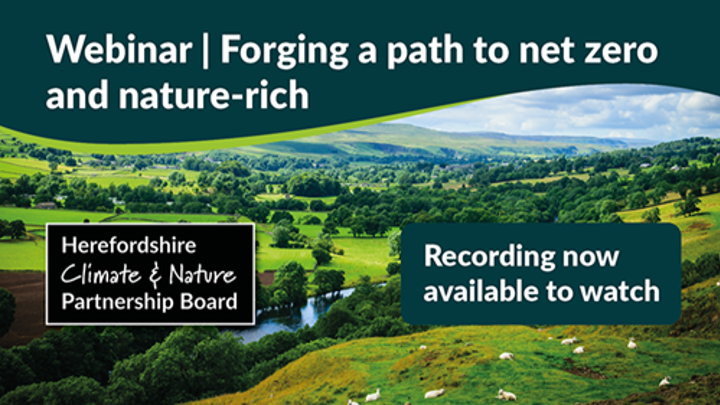
On the 29th February, Herefordshire council, Herefordshire Green Network and members of the Herefordshire Climate and Nature Partnership (HCNP) Board came together to deliver a Webinar, sharing an insight into the achievements, activities and plans of the Board, along with the wider environmental work of Herefordshire Council.
The event was well attended by 81 individuals, with many thought provoking questions asked of the HCNP board, which were followed up in the discussion. If you missed it, don’t worry, the recording of the webinar is available to watch here.
As is often the case we ran out of time, and were unable to answer all questions during the discussion. Here chair of the board, James Marsden, and chair of the Land Use and Farming Sub group, Steve Klenk, answer some of the questions that were missed.
Webinar Attendee: Steve, should one priority [for the farming and land use sub group] be to encourage the switch from producing animals to crops for humans as discussed earlier? (Or adjusting the mix at the least).
Steve Klenk:
There are always consequences of actions. If grassland was not being used for grazing animals what would happen to it. A lot of grassland is low fertility and if used to grow crops would require fertiliser to produce viable crops. Some is on sloping ground and shallow soils which would be prone to erosion. Planting with trees devalues the land and the landowner has little or no income for a long time in most cases.
There is a lot of arable land which produces feedstock for animals, wheat, barley, oats, peas, beans, maize. Some of these can be used to feed humans but because of the UK weather they often don't meet the standards required, they tend to yield lower and if they are not up to standard get downgraded to feedstock.
Herefordshire is blessed with soils and topography that allows a wide range of crops to be grown for human consumption, potatoes, apples, pears, asparagus, brassica vegetables, strawberries, blackcurrants, blueberries to name some. However most of these are seasonal and oversupply can very quickly make the market crash.
During the webinar, James mentioned the Farm Herefordshire survey, within that there was a question about the willingness to reduce stock numbers, there were a number that said they would consider reducing. We didn't ask what it would take and there would be many different answers.
Reducing stocking rates ie numbers per acre would be the ideal but would make the product more expensive. Not every farmer can find a niche market to sell at a higher price and not everyone can afford to pay a higher price for food.
It is not a simple fix.
Webinar Attendee: You also mentioned reduced inputs equals reduced yields and may need compensation. But regenerative/organic farmers would argue that more profit can be made this way not less. And you mentioned success on your farm. Should not this be the message to farmers?
Steve Klenk:
Reduced inputs CAN equal lower yield. It is generally recognised that in changing to a regenerative system there can be a lag where soil is being weaned off artificial inputs and resets. There is often a yield drop during this period. Margins are very tight and some cannot for various reasons risk their business. There is a lot more to it than just reducing inputs. Not all that have converted to Organic stay with it, some have reverted as they have struggled to survive.
The successes on the farm I ran, along with other farms showing good practice have been shown and promoted. Farm Herefordshire as a collaborative group feel that peer to peer learning is a great way to spread the message.
Webinar attendee: The No Farmers No Food campaign is openly anti net zero and appears to have a lot of support. Does this movement threaten Board's ambitions, and the net zero targets generally? And how is Farm Herefordshire responding?
Steve Klenk:
The core NFNF campaign is not anti net zero.
Fringe groups, unmanaged by NFNF core are using the vehicle to their own ends, and in a world of social media this is unavoidable.
Is it Farm Herefordshire’s place to enter this debate, or should it concentrate on its own ambitions and leave the noise to others?
Webinar Attendee: Who runs and approves your farming audits? Sorry if this was mentioned in your presentation!
Steve Klenk:
Herefordshire council appointed 4R to do the audits, they use a calculator run by a company called Agrecalc. There are several others. DEFRA recently published a report comparing the different systems, [which] cost £100k, Agrecalc performed as well if not better than most.
Personally the exact figures are not the important thing, most good systems will give the same solutions for improvement. It is important to do the calculation, understand the conclusions and act upon the recommendations then follow up with another audit at a later date to validate.
Webinar Attendee: A question for Steve. Given the phosphate saturated nature of our farm land is there any good reason why any animal manure should be spread anywhere in the Wye catchment? Could we adopt a ‘Manure Moratorium’? So no spreading UNLESS a farmer can prove through soil testing, an agronomist’s report etc that there was genuine crop need.
Steve Klenk:
I would not agree with the term saturated, language can be emotive.
There are some fields that have high levels of phosphate but not the majority.
Animal manures are a valuable resource when used correctly.
They help to improve soil organic matter, health and water infiltration. A healthy organic soil sequesters more carbon.
Most farmers test soil on a four or five year cycle, and more will do so under part of one of the new schemes. Nutrient in whatever form should only be applied according to crop need. There are regulations in place. The regulatory bodies do not have funding or manpower to carry out enough inspections and enforce the rules.
Whilst we do have livestock at current number the manure has to go somewhere. To export it would create a large increase in carbon emissions both in the transport and the replacement artificial fertiliser that would come into the county to replace it.
There are lots of positives within Herefordshire, lots of work and projects happening. It is easy to get disheartened but there are good people working all over the county and beyond to bring a better future for humans and nature. We should be asking questions but also be positive and praise the good work when it happens.
Webinar Attendee: James, any thoughts around how national targets will be apportioned at local level, given the competing challenges we all face in terms of carbon sequestration, food production etc?
James Marsden:
National targets for nature recovery derive from:
Environment Act 2021 and regulations https://www.legislation.gov.uk/uksi/2023/91/contents/made laid before Parliament in 2023
CoP15 Global Biodiversity Framework (December 2022) 30 x 30 international treaty obligation
Environmental Improvement Plan 2023 (EIP23)
Defra policy guidance https://www.gov.uk/government/publications/delivering-30by30-on-land-in-england which sets out where and how 30 x 30 will be delivered
Defra policy guidance for protected landscapes (January 2024) https://www.gov.uk/government/publications/protected-landscapes-targets-and-outcomes-framework/protected-landscapes-targets-and-outcomes-framework
Defra's long promised Land Use Strategy, due to be published with the indicative 30 x 30 delivery map in December 2023 is still awaited.
A possible apportionment of national targets for nature recovery in Herefordshire could be:
Halt decline in species abundance by 2030 and increase abundance by at least 10% to exceed current levels by 2042 – no wriggle room
Protect and manage 50,000 ha for nature by 2030, plus 12,000 ha protected sites and 500 ha HWT reserves = 62,500 ha (roughly 30% of 218,000 ha county area) – debatable
100% of Herefordshire's SSSIs to have an up-to-date condition assessment by January 2028, and 75% of SSSIs to have management actions in place to achieve favourable condition by 2042 (<50% of SSSIs now in favourable condition) – no wriggle room
Restore/create 11,900 ha of wildlife-rich habitats outside SSSIs by 2042 (i.e. 1/48 ‘fair share’ of EIP23 long-term target) – debatable
Restore/create at least 3,000 ha of wildlife-rich habitats by 2028 (i.e. 1/48 ‘fair share’ of EIP23 interim target). Could be met by Wyescapes and Duchy of Cornwall LR2 projects alone - achievable?
There is no local discretion in the apex target to 'halt the decline in species abundance by 2030' and Local Nature Recovery Strategy process will need to broker local definition of the subsidiary targets for habitat management, restoration and creation to ensure that the abundance of species dependent on the extent, condition and distribution of those habitats does not decline further by 2030, and is increased by 10% above current levels by 2042.
EIP23 (January 2023) states Defra's ambition that farmers will:
contribute at least 50% of the target of bringing protected sites into favourable condition by 2042
contribute at least 80% of the target to restore or create more than 500,000 hectares of wildlife-rich habitat outside of protected areas by 2042; and
65 to 80% of landowners and farmers will adopt nature friendly farming on at least 10-15% of their land by 2030.
Webinar Attendee: James, I like your notion of "no wriggle room" on statutory targets, but history has shown us that statutory targets are routinely missed – e.g. Water Framework and Habitats Regs targets for the Wye. Do you really believe nature targets will be met?
James Marsden:
On 28 February 2024, the Climate Change Committee (CCC) wrote to UK government, as follows:
The UK’s Third Carbon Budget, covering the period 2018 to 2022, was successfully met with emissions 391 MtCO2e and 15% below the level of the budget (2,544 MtCO2e).
Future carbon budgets will require an increase in the pace and breadth of decarbonisation.
The Committee’s unequivocal advice is that surplus emissions from the Third Carbon Budget should not be carried forward.
Earlier on 21 February, Lord Deben (former Chair of CCC) intervened in support of a coalition of eNGOs in a High Court challenge because the government's Carbon Budget Delivery Plan on how the UK's 2030 target - its Nationally Determined Contribution (NDC) adopted under international law - was not clear and transparent about how the 2030 target will be met.
UK government policies are also not aligned with the CCC's 6th Carbon Budget 2033-2037.
The Office of Environmental Protection (OEP) annual progress report (January 2024) found the government remains largely off track to meet its environmental ambitions. https://www.theoep.org.uk/report/government-remains-largely-track-meet-its-environmental-ambitions-finds-oep-annual-progress
The government (post-2010) has made political and fiscal/budget decisions to cut the resources available to environmental regulators (Environment Agency & Natural England), and has not implemented the recommendations of the CCC and OEP, despite its legally binding national targets under the Climate Change Act 2008 and the Environment Act 2021.

